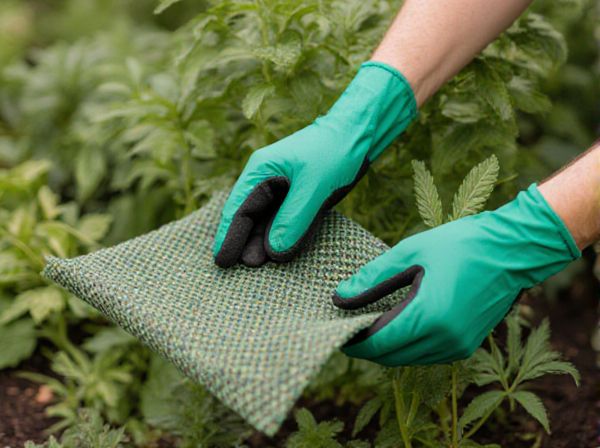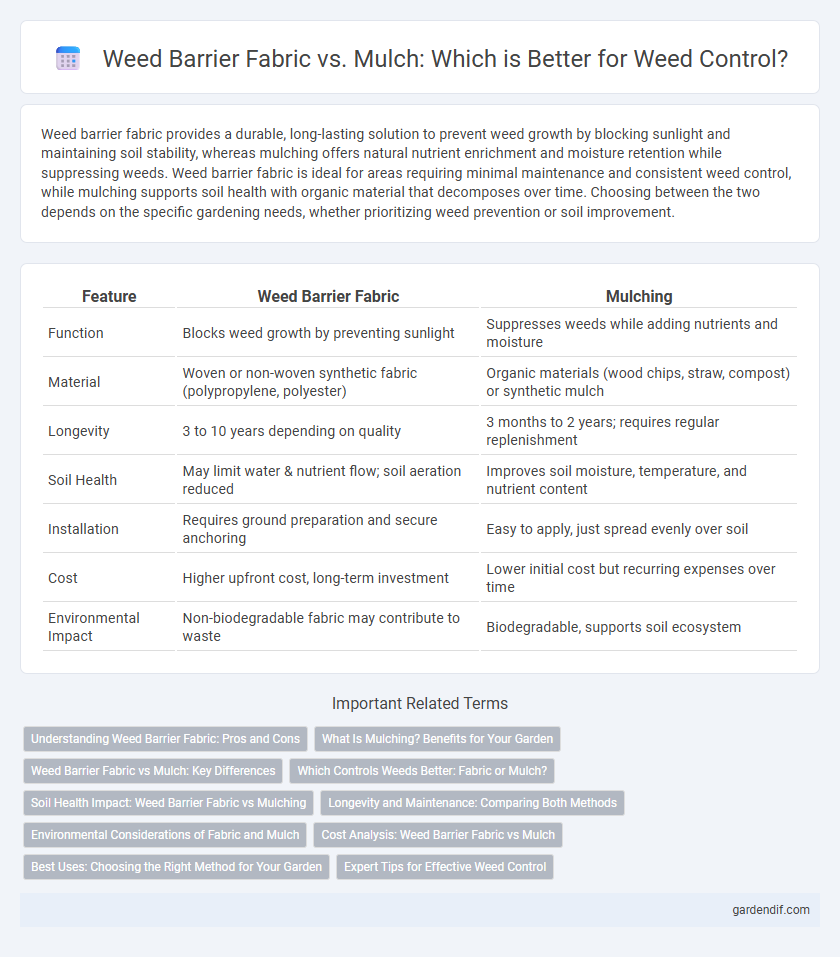
Weed barrier fabric vs mulching Illustration
Weed barrier fabric provides a durable, long-lasting solution to prevent weed growth by blocking sunlight and maintaining soil stability, whereas mulching offers natural nutrient enrichment and moisture retention while suppressing weeds. Weed barrier fabric is ideal for areas requiring minimal maintenance and consistent weed control, while mulching supports soil health with organic material that decomposes over time. Choosing between the two depends on the specific gardening needs, whether prioritizing weed prevention or soil improvement.
Table of Comparison
| Feature | Weed Barrier Fabric | Mulching |
|---|---|---|
| Function | Blocks weed growth by preventing sunlight | Suppresses weeds while adding nutrients and moisture |
| Material | Woven or non-woven synthetic fabric (polypropylene, polyester) | Organic materials (wood chips, straw, compost) or synthetic mulch |
| Longevity | 3 to 10 years depending on quality | 3 months to 2 years; requires regular replenishment |
| Soil Health | May limit water & nutrient flow; soil aeration reduced | Improves soil moisture, temperature, and nutrient content |
| Installation | Requires ground preparation and secure anchoring | Easy to apply, just spread evenly over soil |
| Cost | Higher upfront cost, long-term investment | Lower initial cost but recurring expenses over time |
| Environmental Impact | Non-biodegradable fabric may contribute to waste | Biodegradable, supports soil ecosystem |
Understanding Weed Barrier Fabric: Pros and Cons
Weed barrier fabric offers a durable solution for suppressing unwanted weeds by blocking sunlight and reducing soil erosion, making it ideal for long-term garden maintenance. It allows water and nutrients to penetrate while preventing weed growth, but improper installation can lead to water pooling and root damage. Unlike mulching, which decomposes and enriches soil over time, weed barrier fabric requires minimal replacement, though it may limit organic matter integration.
What Is Mulching? Benefits for Your Garden
Mulching involves applying a layer of organic or inorganic material over the soil surface to conserve moisture, regulate soil temperature, and suppress weed growth. It improves soil health by adding nutrients and enhancing microbial activity as organic mulches decompose. Benefits for your garden include reduced watering frequency, protection from erosion, and improved plant growth by maintaining optimal soil conditions.
Weed Barrier Fabric vs Mulch: Key Differences
Weed barrier fabric is a synthetic or natural material designed to block sunlight and prevent weed growth while allowing water and air to pass through, making it highly effective for long-term weed control. Mulch, typically composed of organic materials like wood chips or straw, suppresses weeds by covering the soil surface, improving moisture retention and soil health as it decomposes. Unlike mulch, weed barrier fabric does not improve soil fertility but provides a more durable, low-maintenance solution against weed proliferation.
Which Controls Weeds Better: Fabric or Mulch?
Weed barrier fabric offers superior weed control by physically blocking sunlight, inhibiting weed seed germination, and providing a long-lasting solution compared to organic mulch, which decomposes over time and may require frequent replenishment. Mulch enhances soil moisture retention and adds nutrients but is less effective in preventing weed growth due to potential gaps and nutrient availability for weed seeds. For optimal weed suppression, combining high-quality woven weed barrier fabric with a layer of organic mulch provides both durability and soil health benefits.
Soil Health Impact: Weed Barrier Fabric vs Mulching
Weed barrier fabric provides effective weed control by blocking sunlight but can limit soil aeration and water infiltration, potentially harming soil microbial activity. Mulching, made from organic materials like wood chips or straw, enhances soil health by conserving moisture, adding nutrients as it decomposes, and promoting beneficial microorganisms. Choosing mulch over synthetic fabric supports long-term soil fertility and ecosystem balance.
Longevity and Maintenance: Comparing Both Methods
Weed barrier fabric typically offers longer-lasting weed control, often remaining effective for up to 10 years, whereas organic mulching generally needs replenishment every 1 to 3 years due to decomposition. Maintenance for weed barrier fabric involves occasional checks to repair tears and prevent soil buildup that can harbor weeds, while mulching requires regular topping up and monitoring for mold or pests. Choosing between the two depends on desired durability and willingness to perform ongoing upkeep, with weed barrier fabric favoring low-maintenance longevity and mulching emphasizing soil health alongside weed suppression.
Environmental Considerations of Fabric and Mulch
Weed barrier fabric reduces soil erosion and conserves moisture by forming a physical barrier, but it can disrupt soil aeration and microbial activity, potentially impacting long-term soil health. Organic mulches like wood chips and straw improve soil fertility as they decompose, fostering beneficial microorganisms and enhancing nutrient cycling without synthetic residues. Both options influence environmental sustainability differently, with fabric offering durability and mulch contributing to ecosystem enrichment and carbon sequestration.
Cost Analysis: Weed Barrier Fabric vs Mulch
Weed barrier fabric typically incurs higher upfront costs compared to mulch due to material and installation expenses, but it offers longer-lasting weed control, reducing maintenance costs over time. Mulch is more affordable initially and improves soil health by adding organic matter, yet it requires frequent replenishment, increasing overall expense in the long run. Evaluating total cost effectiveness depends on garden size, labor availability, and desired longevity of weed suppression.
Best Uses: Choosing the Right Method for Your Garden
Weed barrier fabric provides long-lasting weed control by blocking sunlight and preventing weed growth in vegetable beds, pathways, and around shrubs. Mulching enhances soil moisture retention and adds organic matter, making it ideal for flower gardens and raised beds where soil health is a priority. Selecting the right method depends on your garden's needs for weed suppression, soil improvement, and maintenance frequency.
Expert Tips for Effective Weed Control
Weed barrier fabric provides a durable physical barrier that blocks sunlight and suppresses weed growth while allowing water and nutrients to reach the soil. Mulching, using organic materials like wood chips or straw, enriches the soil and retains moisture, creating an unfavorable environment for weeds. Expert tips recommend combining weed barrier fabric with organic mulch for enhanced weed control, improved soil health, and moisture retention around plants.
Weed barrier fabric vs mulching Infographic

 gardendif.com
gardendif.com